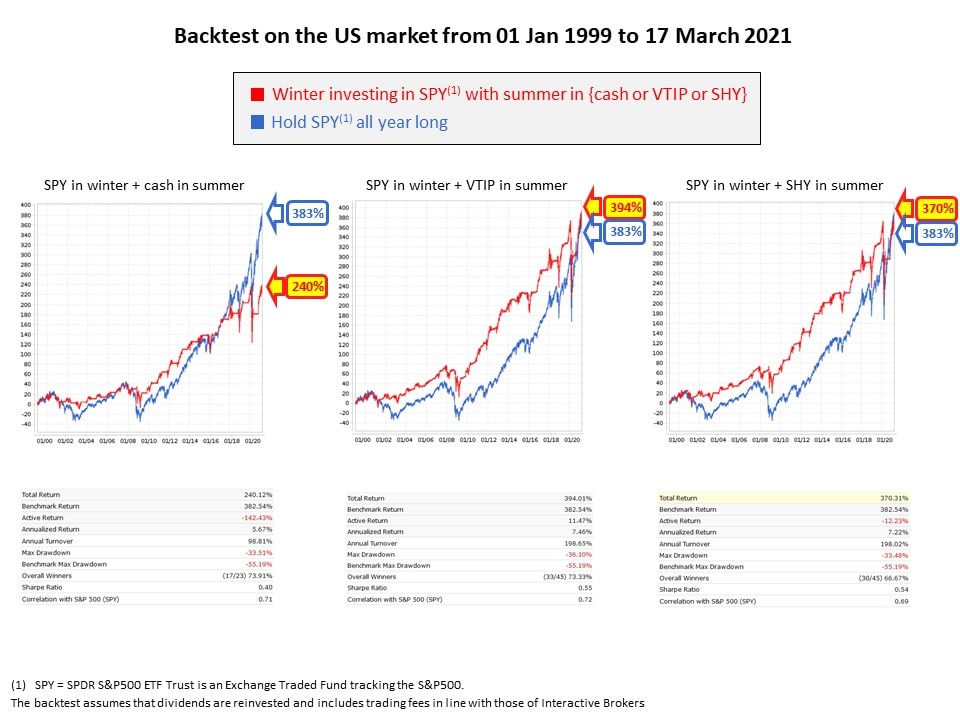Beating the market and most professional investors

02 July 2021
Key take-outs:
- One can beat the main US Equity Index (S&P500) by investing only six months per year in winter in an ETF that equally weighs the components of the S&P500. In summer, one should invest in safe short-term inflation-protected US treasury bonds
- With this strategy, one can easily beat more than 9 out of 10 professional fund managers over the long term (ten to twenty years)
- Finally, this strategy is easy to follow and is systematic, thereby limiting the negative impact of emotions when investing
Part 1 of this series showed that the average investor obtains poor investment returns. A systematic investment process is one way to control the fears and emotions that lead to this disappointing outcome.
Parts 2 and 3 introduced the systematic approach ‘sell in May and go away’, which builds on a strong historical seasonal pattern in equity markets: summers are high risk and low returns. This pattern is robust across geographies (113 out of 114 countries) and across time (3 centuries). It enables an approach whereby no investment risk is taken from May to October (‘stay in cash’) while the investment risk is only taken from November to April (‘buy and hold a broad market ETF such as SPY’). The overall returns are of the same order of magnitude as the returns obtained by staying invested all year long. However, this level of return is obtained while sleeping well and fully enjoying every single summer over this period.
We will now improve upon the basic strategy ‘sell in May and go away’ with a careful selection of specific investment vehicles (Exchange Traded Funds or ETFs for short). This further enhances performance to the point where not only the long-term risk-adjusted performance is better, but the absolute long-term performance is also better than holding the market all year long (i.e. better than holding the ETF 'SPY' all year long). This level of enhanced return is still obtained while sleeping well and fully enjoying every single summer over the period.
We can find much better than 'Cash in summer'.
Cash has nil return and depreciates over time due to inflation. It is particularly true nowadays on the backdrop of strong monetary inflation (interested readers can review the first point of this bitcoin article). One, therefore, needs to seek a risk-free or quasi risk-free vehicle for the summer period.
For example, in the USA, one can use ETFs tracking US short-term treasury bonds such as SHY (U.S. Treasury bonds with remaining maturities between one and three years), or an ETF tracking an index composed of short-term inflation-protected U.S. Treasury bonds (e.g. VTIP, which tracks the inflation-protected public obligations of the U.S. Treasury that have a remaining maturity of fewer than five years).
When using ETFs tracking sovereign obligations, it is vital to ensure that these bonds are virtually risk-free. It is considered the case for US bonds, and one could reasonably argue the same for German or Swiss bonds. French or British sovereign bonds can also be candidates, although the risk is already higher. A later article will look at replicating this strategy in non-US markets.
In addition, one needs to choose short-term maturities as a way to reduce risk further. As of this writing, there is less chance that the US defaults in nominal terms on its sovereign bonds due in three months than in twenty years. In both cases, the risk is small, but since we are looking for a cash alternative, shorter durations are more suitable. I would also propose choosing VTIP over SHY to benefit from protection against inflation. Inflation is likely to feature strongly in the months and years to come. By contrast, the inflation protection only added a minor benefit in the 20-year backtests below as inflation was contained over 1999-Spring 2021.
Click here for a larger image (pop-up window)

The results from the backtests above are clear. Using a safe alternative to cash for the summer season, one can improve annual returns by [1.5% - 2%] over the historical period 1999-2021. It means that anyone could have matched almost exactly the absolute SPY performance over this particular 20-year period, but holding this ETF only in winter and sleeping well in summer (as invested in US short-term bonds).
As long as the US does not nominally default on its short-term bonds, holding VTIP in the summer will continue to outperform cash, particularly in the likely upcoming inflationist environment.
We can find better in winter than tracking the typical Capitalization-Weighted index, e.g. better than the SP500.
The SP500 is an index that includes circa 500 leading large-capitalization U.S. companies and covers approximately 80% of available market capitalization. It is market-capitalization-weighted, which means that its components are weighted by market capitalization: the largest stocks have a larger impact on both the index's long-term performance and daily movement. The ten biggest stocks currently make up roughly 27% of the index's market value. Examples of these ten stocks are Apple, Microsoft, Amazon, Facebook, Google (Alphabet), Tesla.
Using a market-cap weighted index is an investment strategy. Specifically, it means that an investor is betting that the largest companies will continue to do well and actually do better than relatively smaller firms. This has been true in recent years, i.e. roughly 2017-2020 included with the boom of the tech giants. However, there is strong statistical evidence that an equal-weighted SP500 ETF delivers better performance over the long run. In other words, weighing all the component companies equally and giving each of them an equal chance to shine and impact the overall index delivers better performance over a long period of time. This is true for the SP500 and is also true for international indexes (readers can refer to the research paper '10 Years Later: Where In The World Is Equal-weight Indexing Now?'). A further research document attempts to articulate the reasons for this outperformance ('Why Does an Equal-Weighted Portfolio Outperform Value- and Price-Weighted Portfolios?').
Luckily, there is such an ETF for the SP500 index, i.e. an ETF that takes every single stock in the SP500 but weighs them equally. The ticker for this ETF is RSP. Therefore, we can compare and contrast two backtests: the original 'SPY in winter and cash in summer' with 'RSP in winter and cash in summer'. They both use the SP500 stocks in winter, but SPY weighs them by market capitalization, whereas RSP equal weighs them.
Click here for a larger image (pop-up window)

The annualized return over the period 1999-2021 jumps from 5.7% to 8.4%. In other words, this means any individual would have largely beaten the reference benchmark index (the SP500) over this period while only being invested in winter and simply holding cash in summer. However, there is a catch (sort of). It requires accepting to have differing performances in winter than the well-publicized SP500 index. This is not a problem when RSP (equal-weighted) beats SPY (market-capitalization-weighted), e.g. from mid-2000 till mid-2007. But it requires strong emotional control when the opposite happens for several years in a row, e.g. from 2017 till late 2020. The long-term statistics show that RSP (equal-weighted) will overperform SPY (market-capitalization-weighted), but there can be several years in a row when this is not the case. As the saying goes, there is no free lunch. In this case, one needs to trade higher emotional self-control for better performances. We note, however, that the emotional control required is not particularly demanding. After all, the stocks are the same in both ETFs; they are just weighted differently. If anything, RSP is also less risky compared to SPY: should one of the largest stocks by market-capitalization collapse, SPY will take a hit, but RSP will remain essentially unaffected. This did happen in 2001 with the collapse of Enron.
Putting it all together: RSP (equal-weighted SP500 component stocks) in winter and US short-term treasury bonds in summer.
We now get to combine our upgraded choice of vehicles for winter and summer. We choose an equal-weighted version of the SP500 for winter (RSP) and an ETF tracking short-term inflation-protected U.S. Treasury bonds in summer (VTIP).
Click here for a larger image (pop-up window)
The results are spectacular over the backtest period 1999 - March 2021:
- The annualized return of RSP/VTIP is much better than SPY/cash: 10.3% vs 5.7%
- The annualized return of RSP/VTIP also beats holding SPY 'all the time' (10.3% vs 7.4%). Yet, one can sleep soundly in summer as invested only in inflation-protected US short-term bonds.
- Logically, statistical measures such as Sharpe and Sortino ratios are also significantly better for RSP/VTIP over SPY/cash and over SPY 'all the time', i.e. {0.7 and 1.03} vs {0.40 and 0.56} vs. {0.42 and 0.56} respectively.
As mentioned above, the trade-off for this achievement is to emotionally accept a different performance in winter than the one reported all over the media. The media reports the SP500 benchmark index, which is capitalization-weighted (i.e. tracked by SPY when including dividends). By contrast, RSP is composed of the same stocks but has them all weighted equally. Most years, RSP statistically beats SPY, but there are years (sometimes several in a row) when the opposite happens, e.g. from early 2017 to late 2020. One needs to be able to stick with the strategy during these years. In summer, the strategy is not invested in equity markets but in safe short-term inflation-protected US bonds; therefore, one gets to enjoy this period of the year fully.
As a final upside, it is worth mentioning that this strategy would have handily beaten more than 94% of professionally managed US large-cap funds. In general, fund managers find it very difficult to beat the benchmarks. This will be the subject of another article, but impatient readers can already refer to the latest S&P SPIVA US scorecard here with the key table on page 9 copy-pasted below. Did you know you could easily outperform nine out of ten professionals? Well, now you know...


